
A reverse mortgage is a type of loan available to homeowners. It's designed primarily for older individuals who want to convert a portion of their home equity into cash. This financial option can help seniors who seek to enhance their monthly income without needing to sell their homes. With a reverse mortgage, the homeowner borrows against the home’s equity, receiving funds without the requirement of monthly repayment. The loan is repaid later, typically when the homeowner sells the house, moves out, or passes away.
How Reverse Mortgages Work
The process begins with a homeowner taking out a reverse mortgage on their property. Unlike traditional mortgages that require monthly payments, reverse mortgages allow homeowners to receive payments. Upon applying, homeowners must meet specific criteria, including age, home value, and existing mortgage requirements. After approval, the lender disburses money based on equity, with options for one-time payments or monthly installments.
Interest accumulates over time, added to the loan balance instead of requiring monthly payments. Homeowners remain in the property as long as they meet loan conditions, including paying property taxes, homeowners insurance, and maintaining the home.
Types of Reverse Mortgages
There are three primary types of reverse mortgages:
- Home Equity Conversion Mortgages (HECM): These are insured by the Federal Housing Administration (FHA) and are the most common type. HECMs allow borrowers to access a substantial amount of their home equity.
- Proprietary Reverse Mortgages: Offered by private lenders, these loans cater to homeowners with high-value properties. They usually provide more funds than standard HECMs.
- Single-Purpose Reverse Mortgages: These are less common and typically offered by state or local government agencies. They serve a specific purpose outlined by the lender, like home repairs or property taxes.
Eligibility Criteria for Reverse Mortgages
Homeowners must meet several conditions to qualify for a reverse mortgage. Borrowers need to be at least 62 years old. The home must be the primary residence, and the homeowner needs to have sufficient equity in the property. Lenders often require applicants to demonstrate their ability to meet ongoing financial obligations, including taxes and insurance.
A financial assessment conducted by the lender evaluates the homeowner's overall financial health to ensure they are capable of managing ongoing costs associated with the home.
Advantages of Reverse Mortgages
One of the primary benefits of a reverse mortgage is financial flexibility. It allows seniors to access cash without selling their homes, enabling them to cover living expenses or healthcare costs. Homeowners can also enjoy tax-free income, as reverse mortgage proceeds do not count as income for tax purposes. Furthermore, borrowers can remain in their homes, addressing the emotional and physical aspects of aging in place while maintaining ownership.
Potential Drawbacks of Reverse Mortgages
While reverse mortgages offer clear benefits, they come with certain disadvantages. One significant concern is the effect on inheritance. The loan balance grows over time, which can deplete the estate left behind for heirs. Homeowners must also continue maintaining the home and paying taxes; failure to do so may result in foreclosure.
Additionally, it's important for potential borrowers to understand the costs associated with reverse mortgages, such as upfront fees and interest rates that may be higher than traditional loans.
| Type of Reverse Mortgage | Description | Eligibility |
|---|---|---|
| HECM | Insured by FHA. Most common type. | 62 years or older, primary residence. |
| Proprietary | Offered by private lenders for high-value homes. | 62 years or older, homeowner with substantial equity. |
| Single-Purpose | Used for specific purposes, like home repairs. | Varies based on lender requirements. |
FAQ - Reverse Mortgages Explained
What is a reverse mortgage?
A reverse mortgage is a loan that allows homeowners aged 62 or older to convert part of their home equity into cash without having to make monthly mortgage payments.
How does a reverse mortgage work?
Homeowners borrow against their home equity and receive funds either in a lump sum, monthly payments, or a line of credit. The loan is repaid when the homeowner sells the house or passes away.
Who qualifies for a reverse mortgage?
Eligibility typically requires the homeowner to be at least 62 years old, live in the home as their primary residence, and have sufficient equity.
What are the types of reverse mortgages?
The main types are Home Equity Conversion Mortgages (HECM), proprietary reverse mortgages, and single-purpose reverse mortgages.
What are the risks associated with reverse mortgages?
Risks include the potential depletion of equity that could affect inheritance, the continuity of home maintenance and tax payments, and possibly high fees.
Reverse mortgages are loans for homeowners 62 and older, allowing them to convert home equity into cash without monthly payments. The loan is repaid when the borrower sells the home or passes away, providing financial flexibility but requiring careful consideration of costs and risks.
Conclusão sobre Reverse Mortgages Explained.